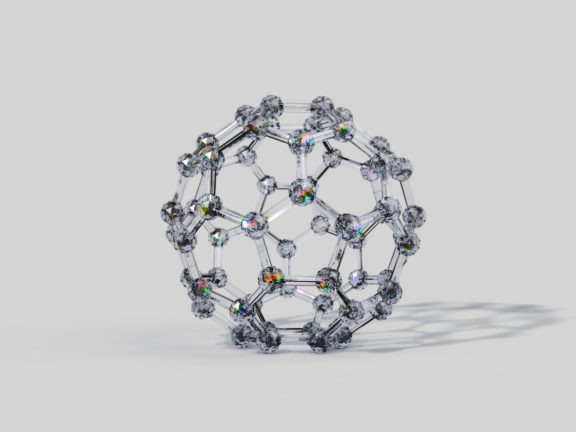Carbon Molecule C60: A Longevity and Health Game Changer

Called “the magic molecule” in the Aug. 1991 issue of Popular Science, the discovery of the Carbon 60 (C60) molecule, shaped like a hollow soccer ball, took academic chemistry and physics by storm. Carbon molecules are subject to intensive research — carbon is a fundamental building block of most of the molecules of life. But C60, sometimes called “fullerene,” is unique among carbons, as it is the only known element with spherical, cage-shaped molecules. The new 60 atom carbon molecule won discoverer Harry Kroto, a British chemist, a 1996 Nobel Prize.
Researchers observed the remarkable characteristics of C60, such as its geometric structure of hexagons and pentagons, radioactivity resistance, and behavior like a molecular ball bearing — and saw infinite possibilities, mostly in the realm of semiconductors, industrial lubricants, and batteries. Because of its unusual geometric construction, the molecule was named “buckminsterfullerene” in honor of Buckminster Fuller, an American inventor of the geodesic dome.
Studies uncovered other unique C60 properties, including wave-particle behavior like light photons, superconductive capacities, and the likelihood that C60 could be the most potent known antioxidant.
Now, as science and medicine pursue the holy grail of a prolonged, healthy human lifespan, C60 is finding popularity as a dietary supplement and is being investigated by drug manufacturers.

Life Extension Discovery
In 2012, researchers at the University of Paris were studying the C60 molecule to determine its toxicity. One control group of lab rats was given nothing; another received C60 in an olive oil medium.
Lead investigator Fathi Moussa and his team were stunned by roughly doubled expected lifespans of rats receiving the molecule. “We are not specialists of aging,” said Professor Moussa. “Our goal was just to study chronic toxicity.”
His paper, published in 2012, broke the news that not only was C60 non-toxic, that the rats who received the molecule outlived control rats by almost two years. Moussa’s control group lived an average 22 to 26 months, while the C60 group had an average survival of 42 months — one rat lived 66 months, unheard of, and “perhaps the longest ever recorded in any experiment,” wrote Lyle Dennis M.D. in Dec. 6, 2012 Huffington Post.
Human Research Findings
Once the C60 molecule was found to be nontoxic in plant oil mediums (avocado, coconut, sunflower, olive) human research began. The resulting studies revealed a remarkable range of biological applications. Because the molecule is such an effective free radical scavenger, shown to be 172 times more powerful than Vitamin C, there are potential impacts to almost every aspect of wellness and longevity — here’s why.
“Free radicals” are “any molecular species capable of independent existence that contains an unpaired electron in an atomic orbital.” These rogue molecules are unstable, reactive, and capable of inflicting damage to DNA, proteins, and other molecules, leading to significant cell damage. A byproduct of cellular metabolism, free radicals are environmentally endemic due to pollution, smoke, industrial chemicals, pesticides, and high levels of atmospheric carbon from methane and fossil fuels.
Free radicals are also byproducts of smoking (anything that burns), alcohol consumption, engineered food chemicals, agricultural insecticides, and herbicides with glyphosate (Roundup®), now present in processed food products.
In the simplest terms, free radicals create oxidative stress in the body. Oxidative stress = inflammation. And inflammation is known to be the source of most diseases and the body’s rate of aging.
By consuming free radical scavengers, a.k.a. antioxidants, inflammation and cellular damage are reduced, improving health and slowing the aging process. Lists of foods high in antioxidants can be found online, but importantly, consuming foods free of pesticides, herbicides and additives are key to reducing body-wide inflammation.
C-60: A Powerful Antioxidant
C-60, with its hollow soccer ball shape, is a powerful free radical scavenger, reducing inflammation throughout the body at molecular and cellular levels. While its mechanism is not yet fully understood, it appears that the hollow molecule grabs, via positive/negative electrical charges, free radical molecules — in essence, “mopping up” oxidative stress.
Other studies show that C60 properties include antiviral activity, nerve protective action, osteoarthritis prevention, insulin resistance prevention, antibacterial properties; it even protects the skin from sunburn and UV damage. In the near future, C60 will likely be a common ingredient in topical sunscreen products.
It works as well in animals as in humans (think pets), and is now marketed as a nutritional supplement by several companies. C60 products use olive oil, coconut oil, and avocado oil as a carrier/medium for the molecule. Animal supplements are also available and are reported to reduce arthritis pain and increase energy in older pets.
One study, designed to determine the level at which C60 becomes toxic, found the C60 to be safe, but that the corn oil delivery medium used was not. Other studies have proliferated — a Google search of “current C60 clinical trials” returned 1,930 results, showing C60 research in cancer treatment, macular degeneration prevention, immune system function, and geriatrics, the science of aging. The molecule is also being studied as a “carrier” agent for drugs.
It’s hard to argue with the fast-growing body of C60 research — this article has not touched on industrial, semiconductive, photovoltaic, and energy storage applications. While Gaia does not recommend or endorse any supplements, specialized diets, or treatment modalities, reporting on C60 research puts information in front of readers, allowing them to draw their own conclusions.
Alternative Protocol Could Prevent, Reverse Alzheimer's Disease

Alzheimer’s disease is on the rise and has become one of the more alarming public health issues. But what if, by using a holistic approach to treating this disease, there was a way to prevent and reverse the onset of Alzheimer’s?
Researchers have studied the disease for over a century, and while they’ve come to understand the mechanisms that lead to Alzheimer’s, there haven’t been significant breakthroughs in finding a viable treatment to prevent patients’ decline into dementia and death. Dr. Ilene Naomi Rusk is a behavioral neuroscientist and co-director of the healthy brain program in Boulder, CO, who has focused her life’s work on the disease.
Dr. Rusk is one of many doctors who now ascribe to the protocols of Dr. Dale Bredesen, which shows that a personalized, holistic approach to Alzheimer’s can not only prevent the disease but even reverse its onset in early phases. But when she began her work, they were looking for one single cure.
“I started in this field in the ‘80s looking at single-targeted strategies for dementia thinking that there would be a silver bullet because that’s the way we thought — receptors, specificity, working with a targeted approach to one brain chemical, for example, acetylcholine would be the answer,” Dr. Rusk said. “It turns out, it isn’t the answer, so there’s a background. All of this new and exciting work in dementia is because we have a foundation of what doesn’t work. If you spoke to any neurologist, any neuropsychologist, any physician they would say ‘No, we don’t really have anything that’s disease-modifying for Alzheimer’s disease, and nothing that slows progression.’ It certainly lends credence to a new approach, and the new approach to me emerged in 2016 when I read a paper by Dr. Bredesen.”
In a proof-of-concept trial, Dr. Bredesen looked at 25 patients suffering from Alzheimer’s disease and evaluated their cognitive ability before and after they followed protocols that focused on a number of lifestyle and environmental factors believed to contribute to Alzheimer’s.




































